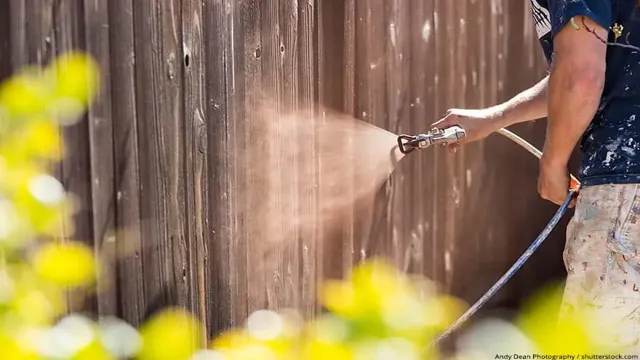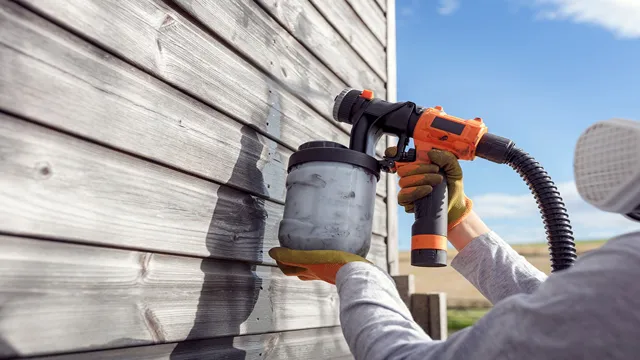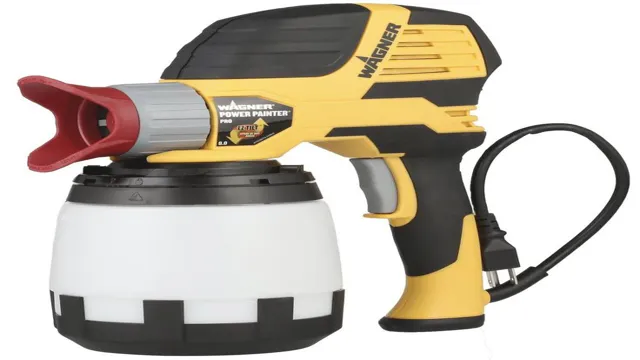Can You Stain a Fence with a Paint Sprayer? Pros, Cons, and Tips.

Do you want to add curb appeal to your home by giving your fence a new look? Spray staining is an excellent way to refresh your fence quickly and easily. It is a simple and effective method that delivers a lasting finish without requiring a lot of effort. Spray staining your fence is, however, not as straightforward as it may seem.
Many factors come into play, such as the type of stain, the equipment, the weather, and the prep work. In this blog, we will examine everything you need to know about spray staining your fence, from the benefits to the drawbacks and the essential steps to follow. So, grab a cup of coffee and let’s dive in!
Benefits of Using a Paint Sprayer for Fence Staining
Yes, you can stain a fence with a paint sprayer, and there are many benefits to doing so. Using a paint sprayer offers uniform and efficient coverage, which means that you can complete the job quickly and with minimal effort. With a paint sprayer, you can easily apply a consistent layer of stain, ensuring that all areas of the fence are covered evenly.
The tool produces a fine mist of stain, which reaches areas that may be difficult to access with traditional brush painting methods. This means that you can achieve a more thorough coverage without leaving any unsightly streaks or brush marks. Additionally, using a paint sprayer can help you save money.
It requires less stain than the traditional brush and roller methods and offers a more controlled application, meaning that you’ll waste less product. Consequently, using this tool will ultimately reduce the number of purchases needed to complete the project. Overall, a paint sprayer is a great investment that can make fence staining quick, easy, and hassle-free.
Efficiency
Using a paint sprayer for fence staining is an efficient way to get the job done. With a sprayer, you can cover large areas of your fence quickly and evenly. This saves you time and energy compared to using a brush or roller.
Plus, the sprayer can get into areas that may be difficult to reach with traditional methods. Another benefit is that the sprayer can apply a thin, even coat of stain, which helps prevent over-saturation and dripping. Additionally, using a sprayer can minimize the amount of stain that is wasted, as well as reduce the risk of overspray, which can result in a messy and uneven finish.
By using a paint sprayer, you can make fence staining a less time-consuming and more enjoyable task.

Coverage
If you’re looking to stain your fence, using a paint sprayer instead of a brush or roller can provide numerous benefits. For starters, a paint sprayer saves time and effort as it allows for quicker coverage of large surface areas. This also means that you can achieve a more uniform and consistent finish, with no brush marks or roller streaks to worry about.
Additionally, paint sprayers are versatile and can work well with different types of stains, including oil-based and water-based options. They also result in less wasted product as the sprayer atomizes the stain into fine particles, reducing overspray and minimizing the need for touch-ups. Overall, using a paint sprayer for your fence staining project can provide a more efficient and attractive result with less effort and waste.
Uniformity
When it comes to staining your fence, uniformity is key to achieving a professional and polished finish. That’s where using a paint sprayer for fence staining comes in. A paint sprayer allows for the even distribution of stain, ensuring that every part of your fence receives the same amount of coverage.
This means that you can avoid those frustrating brushstrokes and splotches that can occur when using traditional staining methods. Plus, a paint sprayer can save you a significant amount of time and effort. Rather than manually applying the stain with a brush or roller, a paint sprayer can cover a large surface area in a short amount of time.
This not only speeds up the staining process but also reduces the physical strain on your body. Ultimately, using a paint sprayer provides an efficient and effective solution for achieving a uniform and professional-looking fence.
Factors That Affect Spray Staining Your Fence
Can you stain a fence with a paint sprayer? Yes, you can, but there are certain factors that can affect the outcome of the spray staining process. One of the factors to consider is the weather. If it’s too windy, the paint may not stick to the fence properly, and if it’s too hot or humid, the paint may dry too quickly or not adhere well.
Another factor is the type of paint you use. Not all paints work well with all types of paint sprayers, so it’s important to choose a paint that is compatible with your sprayer. Additionally, the type of fence material can also affect the outcome of spray staining.
Rough or porous surfaces may require more paint or a different type of sprayer to ensure even coverage. Ultimately, proper preparation and technique are essential for a successful spray staining project, so make sure to read the manufacturer’s instructions carefully and practice on a test surface before tackling your fence.
Type of Fence Material
When it comes to staining your fence, the type of material you choose can affect the outcome and the longevity of the stain. For example, if you have a wooden fence, the type of wood can make a difference in how well the stain takes to the wood. Softwoods like pine tend to absorb stain more readily than hardwoods like oak, which can take longer to absorb and may require a pre-stain conditioner.
Additionally, if you have a metal or vinyl fence, you may need to use a specific type of spray stain designed for those materials. Other factors that can affect spray staining your fence include the weather conditions, the age and condition of the fence, and the type of sprayer and stain you use. To ensure a successful spray staining project, it’s important to do your research and choose the right materials and tools for your specific fence.
Don’t hesitate to ask for advice from a professional or an expert in your local home improvement store. So, whether you are staining your fence to increase its aesthetic appeal or to protect it from damage, be sure to consider the material and factors that can affect the spray staining process to ensure a smooth and long-lasting finish.
Weather Conditions
When it comes to staining your fence, weather conditions play a crucial role in achieving a perfect finish. In fact, adverse weather conditions can ruin your staining project, leaving your fence looking uneven and unappealing. One of the most significant factors that affect spray staining your fence is temperature.
High temperatures can cause the stain to dry too quickly, whereas low temperatures can make it hard for the stain to dry, leading to blotchiness. Additionally, humidity can also affect the drying time, as high humidity can cause the stain to take longer to dry, leading to an uneven finish. Windy conditions also pose a challenge, as they can cause overspray, leading to a messy and uneven outcome.
Therefore, it is essential to consider the temperature, humidity, and wind conditions before embarking on your fence staining project. By doing so, you will ensure that you achieve a stunning and uniform finish that will last for years to come.
Spray Gun Quality
When it comes to spray staining your fence, the quality of your spray gun can make a big difference. A high-quality spray gun can help you achieve even coverage and prevent overspray, which can save you time and money in the long run. But what factors affect spray gun quality? One important factor is the nozzle size.
A larger nozzle can handle thicker stains, while a smaller nozzle is better for thin, lightweight stains. Another factor to consider is the pressure of the spray gun. Too much pressure can cause overspray and waste your stain, while too little pressure can result in an uneven finish.
The material of the spray gun is also important. Plastic spray guns are lightweight and affordable, but they may not hold up well over time. Stainless steel or aluminum spray guns are more durable but may be more expensive.
By choosing the right spray gun and considering these factors, you can achieve a beautiful, even finish on your fence.
Tips for Spraying Your Fence with a Paint Sprayer
Yes, you can definitely stain a fence using a paint sprayer. It’s actually a faster and more efficient way of staining your fence compared to using a brush or roller. However, there are some tips you need to keep in mind before you start spraying.
First, make sure to prep your fence properly by cleaning it thoroughly and allowing it to dry completely. You also need to protect any nearby plants, furniture, or structures from overspray by covering them up. It’s also important to wear protective gear like gloves and goggles to avoid getting the stain on your skin or in your eyes.
Once you start spraying, make sure to keep a consistent distance from the fence and move the sprayer in a back-and-forth motion, overlapping each pass slightly to ensure even coverage. Finally, check for any missed spots or uneven areas and touch them up as necessary. With these tips in mind, you can achieve a beautiful, professional-looking finish on your fence using a paint sprayer.
Prepare the Surface
Before you start spraying your fence with a paint sprayer, it’s essential to prepare the surface properly to ensure the paint adheres correctly and provides long-lasting results. Begin by cleaning the fence to remove any dirt, debris, or loose paint using a pressure washer or a scrub brush and a mixture of water and detergent. Allow the fence to dry completely before sanding the surface to smooth out any rough spots or peeling paint.
Next, cover any nearby plants, bushes, or other surfaces that you don’t want to paint with plastic sheeting or drop cloths. Finally, inspect the fence for any structural damage or loose boards that need repair before starting the paint application. Proper preparation will ensure the success of your fence painting project, and you’ll be left with a beautiful, freshly painted fence that will last for years to come.
Choose the Right Spray Tip
When it comes to painting your fence with a spray gun, choosing the right spray tip is crucial. The spray tip size determines how much paint will be delivered, the speed at which it will be applied, and the type of coating you can use. A narrow tip will produce a finer mist, while a wide tip will spread the paint more evenly.
Before you begin, it’s important to determine the type of coating you will be using and the surface you’ll be painting. Once you have this information, you can choose the appropriate spray tip for your project. A small tip, such as a 515, is ideal for painting fences because it allows for greater control and precision when spraying.
This will result in a more even coating and a smoother finish. Additionally, make sure to adjust the pressure of the spray gun to match the tip size to ensure that the spray is consistent and even. By choosing the right spray tip, you’ll be on your way to a beautiful fence that will last for years to come.
Wear Protective Gear
When it comes to painting your fence with a paint sprayer, wearing protective gear is essential. The sprayer generates a lot of mist, which can quickly settle on your skin, hair, and clothing and cause irritation. To prevent this, you should wear a mask or respirator, safety glasses or goggles, gloves, and a long-sleeved shirt.
Also, ensure that the protective gear fits you properly to avoid any gaps, which could expose you to dangerous chemicals. Inhaling paint fumes can cause respiratory issues, so it’s essential to wear a mask that filters out hazardous particles. Additionally, you should avoid spraying on windy days to prevent the mist from blowing into your face.
In conclusion, wearing protective gear is crucial when using a paint sprayer to ensure your safety while painting your fence.
Practice on a Scrap Piece of Wood
Spraying Your Fence with a Paint Sprayer If you’re looking for a quick and easy way to paint your fence, then using a paint sprayer might be the perfect solution for you. However, before you start spraying your fence, it’s important to practice on a scrap piece of wood first. This will help you get a feel for the sprayer and make sure that you’re comfortable using it before you start working on your fence.
Once you’re ready to get started, there are a few tips that can help you get the best results possible. Firstly, make sure that you properly prepare the surface of your fence before spraying. This means cleaning any dirt or debris off of it and allowing it to dry completely.
You may also need to sand it down or fill any cracks or holes in the wood. Next, choose the right type of paint for your fence and make sure that you have enough of it. You don’t want to run out of paint halfway through the job and have to stop to go buy more.
When you’re ready to start spraying, hold the sprayer about 6-8 inches away from the fence and move it in a back-and-forth motion. Be sure to overlap each pass slightly to ensure even coverage. It’s also important to use a steady, consistent motion to avoid any drips or uneven spots.
Finally, make sure that you clean your sprayer properly after you’re done using it. This will help it last longer and work better in the future. Overall, spraying your fence with a paint sprayer can be a great way to get a professional-looking finish quickly and easily.
By practicing on a scrap piece of wood first and following these tips, you can be sure to get the best results possible.
Steps for Spray Staining Your Fence with a Paint Sprayer
Yes, you can definitely stain your fence using a paint sprayer. It is actually a great option as it saves a lot of time, provides an even finish, and reaches narrow areas that brushes cannot. But the process needs careful consideration.
First, prepare your fence by removing dirt, debris, and any old stain. Then, choose a well-ventilated area to work in, and protect your surroundings with drop cloths. Next, select a high-quality stain suitable for your fence type, and test it on a small portion to check the color and consistency.
After the preparation, start spraying evenly and smoothly, overlapping each pass slightly. It’s essential to maintain the correct distance and pressure while spraying to prevent drips and unevenness. Finally, allow the stain to dry thoroughly before applying a second coat if needed.
The process requires a bit of patience, but with a bit of practice, you’ll end up with a beautifully stained fence that will last for years to come.
Clean the Fence
Spray Staining the Fence with a Paint Sprayer When it comes to improving the look of your fence, spray staining with a paint sprayer is a great option. Before starting, make sure to clean the fence thoroughly, removing dirt, debris, and any flaking or chipping paint. Once your fence is clean and dry, choose a high-quality stain that suits your taste and climate.
Next, prep your paint sprayer, adjusting the pressure and spray pattern to achieve the desired effect. Then, start from the top of the fence and work your way down, holding the sprayer at a consistent distance from the surface. Make sure to overlap each spray pass slightly to ensure even coverage.
Take your time and be patient, allowing each coat to dry fully before applying additional layers. When finished, your fence will look like new, with a fresh pop of color and added protection against the elements. Spray staining your fence with a paint sprayer is a straightforward process that can be completed by homeowners with some basic DIY skills and equipment.
So why not give it a try and breathe new life into your outdoor space?
Apply the Stain
Once you have prepped your fence properly, it’s time to apply the stain. Using a paint sprayer can make this process much easier and faster. Begin by pouring the stain into the sprayer’s reservoir and adjusting the nozzle to the desired spray pattern.
It’s best to start at the top and work your way down so that the excess stain can drip down the fence. Keep the sprayer at a constant distance from the fence to avoid uneven application. It’s important to overlap each pass to ensure even coverage.
Don’t forget to spray the ends and edges of the fence boards as they may absorb more stain. Once you have finished, walk along the fence line to check for any missed spots, and touch them up as needed. Remember to clean the sprayer thoroughly after use to avoid clogs and damage.
With these simple steps, you can achieve a beautifully stained fence in no time.
Backroll and Feather Edges
Spray Staining, Paint Sprayer, Backroll and Feather Edges If you’re looking for an efficient and easy way to stain your fence, using a paint sprayer is a great option. However, there are a few steps you should take to make sure your fence looks evenly coated and not blotchy. Before starting, make sure to clean your fence thoroughly and allow it to dry completely.
Then, protect any nearby surfaces with plastic sheeting or drop cloths. Next, use your paint sprayer to apply the stain to your fence, making sure to spray in even strokes and move your arm steadily. After you’ve applied the stain, use a roller (otherwise known as backrolling) to distribute the stain evenly and feather out any excess.
Finally, let the stain dry completely before removing the plastic sheeting and enjoying your refreshed fence! With these simple steps and a steady hand, your fence will look like new in no time.
Keep a Wet Edge
If you’re looking to stain your fence using a paint sprayer, it’s essential to keep a “wet edge” to ensure an even finish. Here are some steps to follow to achieve great results. First, make sure to clean your fence thoroughly before starting.
Any dirt, debris, or mildew can affect the outcome of your project. Then, choose a high-quality stain that is compatible with your sprayer. It’s important to apply the stain evenly to avoid any noticeable differences in color.
Before starting, test the sprayer and practice on a small, inconspicuous area. Once you’re ready to begin, start spraying at the top of the fence and work your way down, maintaining a consistent distance from the surface. Always keep a wet edge, which means overlapping each pass of the spray gun to avoid drying lines or overlaps.
Finally, allow the stain to dry completely before applying a second coat, if necessary. By following these steps, you’ll have a beautifully stained fence that adds curb appeal to your home.
Conclusion
So, can you stain a fence with a paint sprayer? The short answer is yes, absolutely! While staining a fence may seem like a daunting task, using a paint sprayer can make the process quick and efficient. Plus, it allows you to achieve an even coat on every inch of your fence, giving it a polished and professional look. So go ahead, grab your sprayer and show that fence who’s boss!”
FAQs
What type of sprayer is best for staining a fence?
A paint sprayer with a HVLP (High Volume, Low Pressure) system is best for staining a fence. This type of sprayer provides even coverage and reduces overspray.
Is it necessary to thin the stain before using a paint sprayer?
Yes, most stains need to be thinned before using a paint sprayer. Follow the manufacturer’s instructions for dilution ratios and consistency.
Can you use a regular paint sprayer for staining a fence?
Yes, you can use a regular paint sprayer for staining a fence, but it may not provide the same level of control and precision as a dedicated stain sprayer.
Should you use a primer before staining a fence with a paint sprayer?
It depends on the condition and type of wood. For new and untreated wood, a primer is recommended to prevent bleeding and promote adhesion. For previously stained or sealed wood, a primer may not be necessary.
How do you prepare a fence for staining with a paint sprayer?
Clean the fence thoroughly and remove any dirt, debris, or loose paint. Sand the surface lightly to ensure proper adhesion. Cover surrounding areas to prevent overspray.
Can you stain a fence in humid or rainy weather with a paint sprayer?
It is not recommended to stain a fence in humid or rainy weather as the excess moisture can affect the adhesion and drying process of the stain. Wait for dry and clear weather conditions.
How do you maintain a paint sprayer after staining a fence?
Clean the sprayer thoroughly with water or a recommended cleaning solution. Store it properly and follow manufacturer’s instructions for maintenance and storage.



